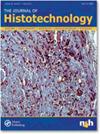2021 Journal of Histotechnology awardees and what this December issue has to offer.
IF 0.6
4区 生物学
Q4 CELL BIOLOGY
引用次数: 0
Abstract
Journal of Histotechnology (JOH) awards were presented at the virtual 2021 National Society for Hisotechnology convention this past September. The Outstanding Publication in JOH for 2021 (formerly Diamond Cover Award) was presented to Katherine Crosby and her coauthors for YAP vs. TAZ: differences in expression revealed through vigorous validation of target-specific monoclonal antibodies [1]. The JOH Editor’s Award went to Dr. Sheila Criswell for her interaction with JOH as an author, reviewer, and Editorial Board member. Congratulations to the awardees and a thank you for your contributions and continuous support to JOH. This issue has a ‘first’ article with a video accompanying April Myers and colleagues' paper on tissue clearing, which has innovative methodologies developed over the last 22 years. This paper is a review of various clearing methods with one used in this practical study using fluorescence, immunohistochemistry, and creating 3D structure to visualize optic nerve degeneration. For those doing cell cultures, the paper by Bujan and colleagues is interesting in that mesenchymal adipose stem cell cultures can be sustained over a very long period of time. The Duckett group from Clemson exclusively used frozen sections to study the effect of ergot alkaloid exposure during gestation on ovine placenta along with double immunofluorescence assays, fluorescence lectin histochemistry, and hematoxylin and eosin staining. For anyone who has never conducted a full study using only cryomicrotomy, full admiration must be given to this group for the amount of work and time involved as compared to using NBF-fixed paraffin-embedded tissues. Eman Abdelzaher Ahmed along with her colleagues has returned to JOH with a study on Egyptian patients with bladder urothelial cancer, the 9 most common cancer worldwide, with LPCAT1 conferring aggressiveness and predicting recurrence of this cancer. One paper is a stroll through history with Izak Dimenstein in his review and participation on the early development of immunohistochemistry when antibodies were defined as cytotoxins from the end of the 19 century to the present time immunohistochemistry. Two technical notes are on practical applications to consider using in laboratories. One deals with the problem encountered in everyday work in visualizing tissue samples during the embedding and microtomy process. Criswell and Sutton performed a comprehensive study on various dyes and stain solutions applied to cell blocks and tissue specimens to enable sample visibility at embedding and microtomy. They also evaluated whether the dyes would interfere with routine staining and some IHC assays. Histotechnicians may want to try the two dying methods determined to work best to have samples more visible at embedding and microtomy. The other paper by Palanisamy and colleagues reported using a novel automated image analysis for quantitating toluidine blue stained murine mast cells. Importantly, this article shows that image analysis has become more global, rather than just novel for quantifying stained cells in histopathology laboratories. This group also compared two toluidine blue staining methods to establish which protocol was simple, reproducible, and provided the best contrast for the stained mast cells. As 2021 comes to an end, hopes are that our readers remained safe from COVID and that the pandemic soon fades away, never to return. I wish everyone a happy, productive 2022.2021年《组织技术杂志》获奖者以及今年12月的这期杂志所提供的内容。
本文章由计算机程序翻译,如有差异,请以英文原文为准。
求助全文
约1分钟内获得全文
求助全文
来源期刊

Journal of Histotechnology
生物-细胞生物学
CiteScore
2.60
自引率
9.10%
发文量
30
审稿时长
>12 weeks
期刊介绍:
The official journal of the National Society for Histotechnology, Journal of Histotechnology, aims to advance the understanding of complex biological systems and improve patient care by applying histotechniques to diagnose, prevent and treat diseases.
Journal of Histotechnology is concerned with educating practitioners and researchers from diverse disciplines about the methods used to prepare tissues and cell types, from all species, for microscopic examination. This is especially relevant to Histotechnicians.
Journal of Histotechnology welcomes research addressing new, improved, or traditional techniques for tissue and cell preparation. This includes review articles, original articles, technical notes, case studies, advances in technology, and letters to editors.
Topics may include, but are not limited to, discussion of clinical, veterinary, and research histopathology.
 求助内容:
求助内容: 应助结果提醒方式:
应助结果提醒方式:


